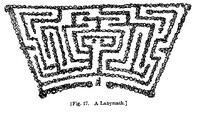In the interior of the park, the plantations were generally disposed either in straight avenues crossing each other, or clumped in the form of circles, stars, squares, etc.; and long vistas were obtained through the avenues divaricating from the house in various directions, over level surfaces. One of the favorite fancies of the geometric gardener was the Labyrinth (fig. 17), of which a few celebrated examples are still in existence in England, and which consisted of a multitude of trees thickly planted in impervious hedges, covering sometimes several acres of ground. These labyrinths were the source of much amusement to the family and guests, the trial of skill being to find the centre, and from that point to return again without assistance; and we are told by a historian of the garden of that period, that "the stranger having once entered, was sorely puzzled to get out."

